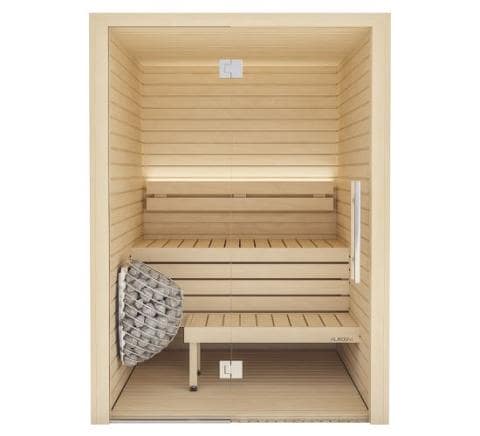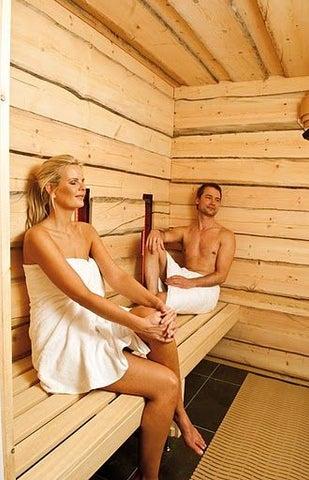Some Of Traditional Sauna
Some Of Traditional Sauna
Blog Article
Traditional Sauna for Dummies
Table of ContentsWhat Does Traditional Sauna Mean?6 Easy Facts About Traditional Sauna ExplainedThe Best Guide To Traditional SaunaSome Known Factual Statements About Traditional Sauna Getting My Traditional Sauna To Work
A lot of the weight shed in a sauna is water loss and is re-gained upon rehydrating. Without a doubt sauna can be a crucial component of a healthy and balanced weight loss program. To consider the differences between traditional and IR saunas, I will separate these right into proven, theoretical, and produced distinctions.Thus, the hottest point in the saunawhich goes to the ceiling straight over the sauna heateris usually between 185 and 190 F. Claims that a standard sauna goes beyond 200 F is merely not real and not relevant for electrical saunas offered in the United States. The temperature for a far-infrared sauna is usually set between 120 and 140 F; nonetheless, unlike the traditional sauna, the objective in and IR area is not to attain a high temperature level.

When a typical sauna has been properly warmed, the sauna wall surfaces are warm, the air temperature level has attained established temperature and the rocks are incredibly heated. As an intriguing side note, the warmed walls and the rocks are producing far-infrared warmth, combined with the warmed air, to develop an "wrapping up warm".
More About Traditional Sauna
When the high temperature is attained, the elements cycle on and off to preserve the heat. Most traditional sauna users appreciate pouring water over the rocks to produce heavy steam to elevate sauna moisture levels. The advantages of putting water over the rocks consist of: making the room a lot more comfy, dampening the nasal passages, and allowing the use of aromatherapy by blending important oils with the water.

When the power goes into the body, it triggers the body temperature to enhance and eventually causes sweat. In an infrared sauna it's vital for the emitters/heaters to continue to be on virtually continuously. Since there is no mass of rocks to retain warmth, the sauna will cool down if the emitters turned off.
Indicators on Traditional Sauna You Should Know
As mentioned over, the sauna bather in an infrared room intends to place himself in front of running emitters to get optimal gain from the warmth. The heating time for both spaces can be really various, depending upon how the spaces are used. For a traditional sauna, a bather needs to enable 30-40 mins for the room to achieve a wanted temperature and to properly pre-heat the rocks.

A well built sauna will generally attain a temperature of 150-160 F in regarding 30-40 mins (Traditional Sauna). For hotter temperature levels, the room may require to warm for a longer period. When the area achieves set temperature, the heating system will cycle on and off, generally operating about 50% of the moment. The insulated walls and the warmed rocks will certainly keep the area hot and at steady temperature levels.
To some, 15 minutes was "lost" while the infrared power warmed the wood panels instead than heating up a body, while others find a pre-heated area to be much more comfy and think a raised beginning temperature level is needed to start sweating. The size of suggested use for every space is about the very same (10-15 mins per session); however, due to the lower air temperature levels and the capacity to feel the effects of infrared heat faster than a conventional sauna, it is not uncommon for an individual to invest a total you can try this out amount of 20-30 mins in an infrared sauna.
The Main Principles Of Traditional Sauna

The average expense per kWH of electrical power in the united state is about $0.11, so a 4.5 kW heating system will set you back approximately $.50 to run for one hour, if the heating system runs continually for one hour. Commonly a sauna heater will compete 75% of the initial hour and 50% of succeeding hours on because the aspects cycle once the established temperature is accomplished.
A 2 person far-infrared room is normally literally smaller sized than a conventional sauna, commonly concerning 4' x 4' or smaller. The IR heater is generally 1.5-1.7 kW making use of a 120 volt 15 amp plug-in solution. Given that the room can be made use of quicker than a sauna space, we will certainly think the area is made use of for to of an hour including warm up time.
There is a rarely discussed difference in the social experience between the two rooms. While our additional info culture has actually shed some of the social advantage of the traditional sauna experience, it can be very socially rewarding (Traditional Sauna). From household time in the sauna, to heart-felt discussions with substantial others, to sauna partiesthe traditional sauna experience can lead to intimate interacting socially
The Greatest Guide To Traditional Sauna
Many greater end infrared rooms include tinted light treatment, noise systems and full-glass fronts.
Report this page